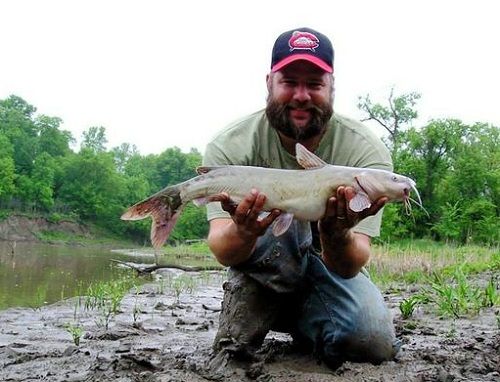Bank Fishing For Channel Catfish
Better by far than any day at the office


It starts with a tap. The line then starts tugging and popping. Carefully raising the fishing rod, I wait until the pull is constant, making sure the circle hook has fastened into the side of the fish's mouth. Once hooked, the fish surges toward the bottom, fighting against the pressure. Finally, after a few minutes of fury, the fish is at the bank and in any hand.
In contrast to large rivers like the Mississippi and the Missouri, a multitude of lazy Midwestern rivers snake across the landscape. These waters are often overlooked for recreation-a shame, as there are fantastic fishing opportunities for anyone willing to wet a line and tussle with one of America's premier sporting fish, the channel catfish.
The swimming tongue
The channel catfish is covered in smooth, scaleless skin. The mouth is tipped with barbels, resembling whiskers. Widely distributed throughout most of the country, the channel catfish is one of the most popular gamefish in the Midwest. They are found in natural rivers and lakes and have also been stocked in impoundments as well.
Slow moving, silty water is where channel catfish are most at home. While they have decent eyesight, they actually locate most of their food through their sensitive skin and barbels. The channel catfish has been called "the swimming tongue," as they can taste a food object with their entire body.
To ensure their widespread success, channel catfish consume a wide range of foods: Dead fish and animal products, live fish, insects, crayfish, shellfish, and plant material.

Gear and bait to use
Channels range in size from one to two pound "fiddlers" to giants tipping the scale over 20 pounds. Fishing on the Red River of the North, near the Canadian border, fisherman can expect to catch plenty of fish weighing in the teens to lower twenties. Most often, though a fifteen-pound fish will be the top end.
Rod and reels for catfish need not be expensive. A six-to-seven-foot medium-action rod will help bring nearly any fish to the bank. Reels, however, are a personal preference. Some fishermen like spinning reels, while others like spin cast, and yet others like bait casting reels. I tend to prefer bait casting reels, in a round configuration. They can hold a tremendous amount of line, have easily adjustable drag, and cast smoothly and cleanly. They also hold up well to the dirt, mud and sand that invariably finds its way into a catfishing reel. A stout, well-built reel is needed, as small and fragile reels will get torn apart on a big fish.
Fifteen-to-20-pound test monofilament line, in a highly visible color, is best. Lighter line can break on underwater objects or even from course sand- heavier lines can take much of the fight out of the fish. Braided line, while tough, is impossible to break off when snagged. Monofilament stretches and eventually snaps, while braided will not and can break the tip of a rod.
Terminal tackle is simple and inexpensive. A few brass swivels, one- to three-ounce No -Roll or pyramid sinkers, glass beads, and circle hooks should be in the tackle box. Circle hooks work well and prevent deep hooking, where the fish swallows the bait.
Small treble hooks and j-style hooks are impossible to remove without killing the fish, whereas circle hooks almost always catch the fish in the corner of the mouth.
Tie a circle hook onto the end of a piece of line sixteen inches long. Tie the other end to a swivel. On the line attached to the reel, thread a sinker onto the line, followed by a glass bead. In slow, shallow water, one ounce of sinker is ample. In faster, deeper water, three or more will make sure the bait gets to bottom and doesn't bounce downstream. Tie to the other side of swivel and you're ready to fish.
Serious fishermen have their own preferred bait, ranging from grocery store items to natural foods. Cheap hotdogs, frozen chicken livers, and frozen shrimp can be bought at the grocery store and put fish on the stringer.
Frozen bait fish, such as goldeye and sucker, can be cut into pieces and threaded on the hook. Goldeyes are sporty fish to catch on light tackle, and enough for bait can be caught in a matter of minutes when the bite is on. The river currant thaws the cut pieces of fish and the scent swirls downstream, calling catfish out of their hiding holes.
Another good option is dip bait, a foul-smelling concoction that is applied to a plastic worm bait. With blood and cheese in the mix, catfish can't help but find it irresistible.
Finding choice locations
Before ever casting a line in the current, pull up an aerial photo of the location you wish to fish. Straight lengths of river, called runs, harbor few catfish. When a river bends, the outside edge with the fastest current will cut away at the bank and dig a hole. The inside bend, the slowest portion of the current, will be shallow with little cover.
The fish prefer to hang out in deep holes and areas with woody debris. Snags of dead trees provide shade, cover and reduced current-catfish hang out and wait for food to slip by.
Once a location is found, it needs to be determined if it's on public or private land. Private land requires permission to access, and many landowners will allow a considerate fisherman access if asked politely.
On public lands, the further from easy access points a person can hike the better. Easy access areas receive the most fishing pressure and educated fish are more difficult to catch.
Get comfortable, cast out a line, and begin the wait. Catfish are mostly scent hunters, so if a bite hasn't occurred within ten minutes rebait or apply more dip bait.
If there isn't a bite within half an hour, pack up and check out the next location. Channel catfish aren't shy and will bite soon if they are present.
On the table
Catfish are absolutely delicious on the table. Fish from one to four pounds are the right size to keep, with larger fish released to fight another day.
Filet a catfish by making cuts along the dorsal fin and down behind the head, and firmly grasp the skin with some pliers. Pull backwards and remove the skin. With a sharp filet knife, filet the white meat off the bones.
Catfish are not the firmest meat, especially during the hot summer months. I like to soak a batch of filets in a bowl of water, with a dash of lemon juice, overnight. This small step firms up the flesh.
Catfish can be fried, broiled, grilled, or baked. No matter the preferred way they to cook, catfish are delicate and tasty, making for a memorable meal!
More Bank Fishing Tips: https://youtu.be/HNiJocsjprY
Pure Fishing Knows Catfish: Read More
https://www.purefishing.com/mitchell-education-no-boat-no-worries-catching-catfish-from-the-shore
Tags:Features

Acreage Life is part of the Catalyst Communications Network publication family.













